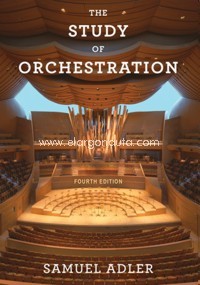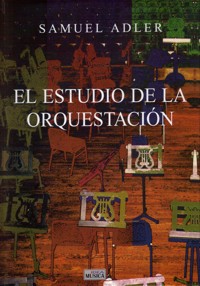
The Study of Orchestration
Adler, Samuel
W. W. Norton & Company. 2016Ficha técnica
- EAN: 9780393283730
- ISBN: 978-0-393-28373-0
- Editorial: W. W. Norton & Company
- Fecha de edición: 2016
- Encuadernación: Rústica
- Dimensiones: 19x26
- Idioma: Inglés
- Nº páginas: 1024
Bajo pedido
Sin stock. Si se pide hoy, se estima recibir en la librería el 13/05/24¡GASTOS DE ENVÍO GRATIS!
PVP. 102,00€
Añadir a la Lista de deseos
Fourth Edition.
The book that set the standard for orchestration texts.
Written by a renowned composer whose works have been performed by major orchestras around the world, The Study of Orchestration is the only text that explores the characteristics of orchestral instruments and shows students how a master composer approaches orchestration. The Fourth Edition invites students to experience the instruments through online audio and video recordings and now offers more coverage of writing for band.
CONTENIDO:
Part 1. Instrumentation
1. The Orchestra?Yesterday and Today
2. Bowed String Instruments
Construction
Tuning
Fingering
Double, Triple, and Quadruple Stops
Divided Strings
Vibrato
Glissando and Portamento
The Bow
Bowing
Special On-the-String Bowings
Special Off-the-String Bowings
Trills and Other Coloristic Effects Using the Bow
Coloristic Effects without the Bow
Mutes
Scordatura
Harmonics
Contemporary String Techniques
3. Individual Bowed String Instruments
Violin
Viola
Violoncello or Cello
Double Bass
4. Plucked String Instruments
Harp
Guitar
Mandolin
Banjo
Zither
5. Scoring for String
Individuality within the Ensemble
Foreground?Middleground?Background
Contrapuntal Writing for Strings
Homophonic Writing for Strings
Using the String Choir to Accompany a Soloist
Transcribing from Piano to Strings
6. The Woodwind Choir (Reed Aerophones)
Construction
Classifying Woodwind Instruments
The Principle of Transposition
Playing Techniques
The Woodwind Section of a Symphony Orchestra
Scoring for Woodwind Instruments
7. Individual Woodwinds
Flute
Piccolo
Alto Flute
Bass Flute
Oboe
English Horn
Other Members of the Oboe Family
Clarinet
?Piccolo? Clarinet: Clarinet in D or E-flat
Bass Clarinet
Others Members of the Clarinet Family
Saxophone
Bassoon
Contrabassoon
8. Scoring for Woodwinds and Woodwind-String Combinations
The Role of Winds in the Symphony Orchestra
The Variety of Orchestral Treatments
Homophonic Writing for Winds
Contrapuntal Writing for Winds
Using the Wind Choir to Provide a Contrasting Color
Using the Wind Choir to Double Other Instruments of the Orchestra
New Types of Articulations For Woodwinds
Special Effects
Transcribing from Piano to Winds and Strings
9. Introduction to Brass Instruments
Composition of the Brass Section
Brass Instruments and the Written Orchestral Score
Overblowing and the Principle of the Harmonic Series
Crooks, Valves, and Slides
Range
Tone Production, Articulation, and Tonguing
Common Characteristics and Effects on All Brass Instruments
Mutes
Muting Devices Other Than Mutes
10. Individual Brass Instruments
Horn
Trumpet
Cornet
Other Members of the Trumpet Family
Trombone
Other Members of the Trombone Family
Tuba
Other Members of the Tuba Family
11. Scoring for Brass, and Brass Combined with Strings and Winds
Early Uses of the Brass Choir
Doubling of Brass Instruments within the Modern Orchestra
Homophonic Writing for the Brass Choir
Using the Brass Choir to Present the Melody
Contrapuntal Writing for the Brass Choir
Climactic Uses of the Brass Choir
Using the Brass Choir to Provide a Coloristic Effect
12. The Percussion Ensemble
Historical Uses of Percussion Instruments within the Orchestra
Number and Distribution of Percussion Players
Notation of Percussion Instruments
Mallets, Beaters, and Sticks
Categories of Percussion Instruments
Instruments of Definite Pitch
Instruments Of Indefinite Pitch
13. Keyboard Instruments
Piano
Celesta
Harpsichord
Organ
Harmonium
14. Scoring for Percussion with Keyboard Alone or in Combination
Percussion Layout in the Full Score
Percussion Section Setup
Uses of the Percussion Section
Part 2. Orchestration
15. Scoring for Orchestra
The Unison-Octave Tutti
The Distribution of Foreground?Middleground?Background Elements within the Orchestra Orchestrating a Melody or Primary Gesture
Using the Orchestra to Create Special Effects
16. The Orchestra as Accompanist
The Concerto
Accompanying the Vocal Soloist, Ensemble, or Chorus
17. Transcribing for Orchestra
Transcribing from Keyboard or Small Chamber Combinations to Orchestra
Transcribing from Band or Wind Ensemble to Orchestra
Transcribing to Various Available Instrumental Combinations
18. The Preparation of Score and Parts
The Orchestral Score Setup
The Reduced Score
The Condensed Score
Preparing Individual Parts
19. Scoring for Band or Wind Ensemble
Scoring for Band
Band Versus Wind Ensemble
The Percussion Section within the Band or Wind Ensemble
The Band and Wind Ensemble Score Setup
Condensed Score
Transcribing from Orchestra to Band or Wind Ensemble







